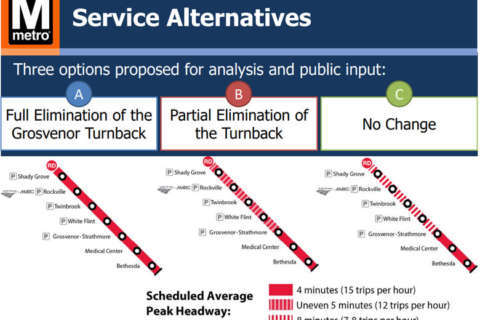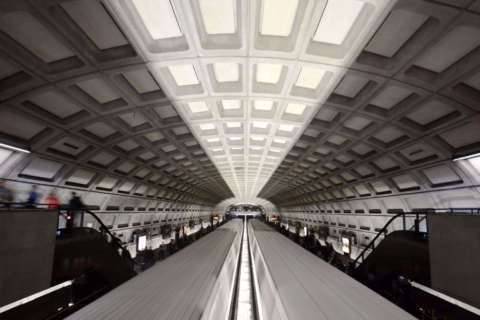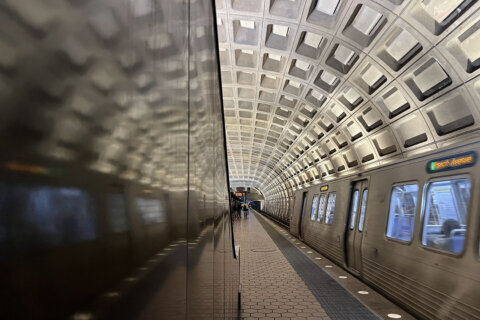WASHINGTON — The Metro Board approved funding Thursday for a series of long-planned bus changes, but also added $1.25 million to the agency’s budget for the year starting July 1 for additional Red Line service that may not happen.
The additional money would pay for six months of operating costs of ending the so-called “Grosvenor turnback” by running all rush-hour Red Line trains to and from Shady Grove instead.
The funding is now embedded in the fiscal year 2019 budget, which will serve as the base year for Virginia’s calculations of cost caps imposed on Metro as part of the agreement to provide a share of new dedicated capital funding for the agency.
“That’s another reason to take the action today as opposed to waiting for July or August or something like that, yeah,” Metro Board Chairman Jack Evans acknowledged after the meeting.
The board is scheduled to be briefed next month on an analysis of whether adding service on the Red Line at rush hour to and from stations between Shady Grove and Grosvenor-Strathmore is even feasible under Metro’s current operating procedures and rules, and whether such additional service would meet federal civil rights requirements.
General Manager Paul Wiedefeld declined to say Thursday whether Shady Grove could handle the extra traffic, until that analysis is completed. Shady Grove did have more trains scheduled in the past than it does today. But at those times, Metro did not always meet its scheduled service levels.
“Ending the Grosvenor turnbacks has been a longstanding objective for improving service for Maryland Red Line riders for both Montgomery County and the state of Maryland,” Maryland Metro Board member Michael Goldman said.
It was promised in a 2015 deal, he argued, when Maryland allowed Metro to fund power upgrades on the Blue and Orange lines. That resolution did direct Metro staff to come up with a plan for possibly ending the Grosvenor turnback in 2018 or 2019 as more new Metro cars arrived. Since 2015, Metro has cut scheduled rush-hour service across the rail system.
While any Red Line change — if one happens — is not expected until January, the bus route changes formally approved Thursday take effect later this month.
Reworked bus service
The bus changes include significant changes for the Columbia Pike lines and several others in Arlington, making the G9 limited-stop Rhode Island Avenue route and 59 14th Street limited-stop route permanent in the District; restructuring a number of lines on the east side of the District, including the U5, U6 and U7; improving other lines; and canceling the V5 and 94 routes. Some service will be replaced by Circulator routes.
The total subsidy increase for the bus changes is expected to be $3.6 million. $2.8 million of that will be covered by the District for routes to which it has requested changes.
For the Red Line, if the maximum increased service is approved, D.C. and Maryland would each pay approximately $430,000 for a half-year of service, while Virginia could pay $390,000.
Goldman, the Maryland Metro Board member, said the improved service is needed because a Metro survey April 30 found that all trains from Shady Grove between 7:45 a.m. and 8:45 a.m. met Metro’s definition of a crowded car, with more than 100 people inside. Metro aims for no more than 100 passengers per car.
He argued extending trains to Shady Grove could draw more riders, encourage more people to use those stations north of Grosvenor (instead of driving there to get a seat on a train), and serve thousands of people expected to move into or start working at new developments in the coming years between White Flint and Shady Grove.
“Improved service all the way up to Shady Grove will not only reduce congestion on Rockville Pike, but will increase people who park at Shady Grove, who park at Twinbrook, who park at White Flint, who park at Rockville, and they will be paying higher fares, so there’s a clear revenue benefit for WMATA, even if you put aside the potential growth … in the near-term future,” Goldman said.
He called the $1.25 million added to the budget Thursday as a placeholder for the Red Line service a “meager amount,” and later a “picayune amount.”
All four federal appointees to the Metro Board voted in the Finance Committee against adding the Red Line funding.
“In order to avoid negative impacts on service and reliability, there was an estimate of a capital investment required of $20 to $30 million,” Steve McMillin said.







